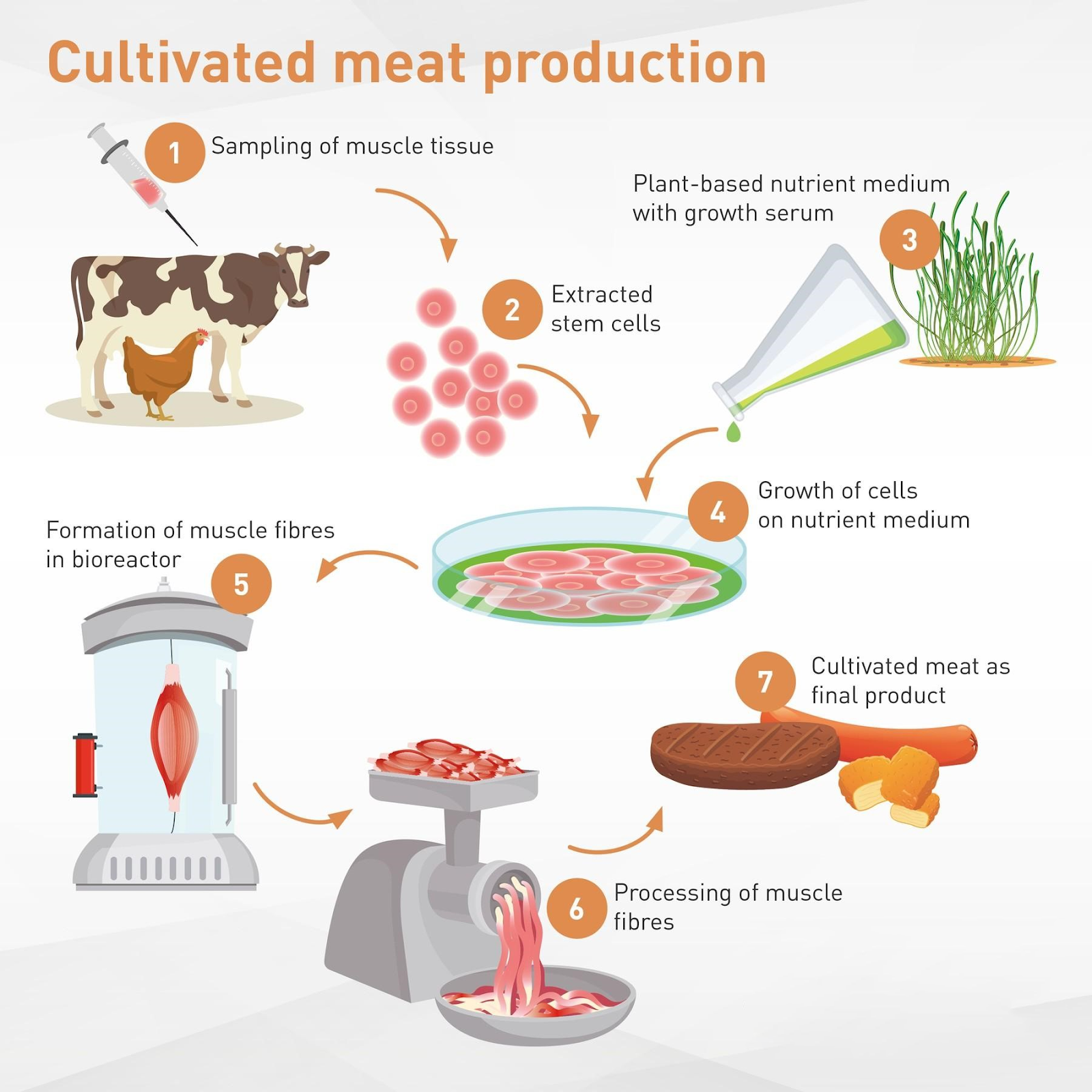Science & Technology
Lab-Grown Meat
- 27 Jun 2023
- 6 min read
For Prelims: Lab-Grown Meat, Cell-cultivated chicken
For Mains: Potential of lab-grown meat in addressing food security, Animal welfare implications of cell-cultivated meat.
Why in News?
Recently, there has been a significant development in the world of sustainable food production with the United States' approval of lab-grown meat, specifically cell-cultivated chicken, by two California-based companies.
- Two California-based companies, Good Meat, and Upside Foods received U.S. government approval to produce and sell the ‘cell-cultivated chicken’.
What is Lab-Grown Meat?
- Lab-grown meat, officially known as cell-cultivated meat, refers to meat that is grown in a laboratory setting using isolated cells derived from animals.
- These cells are provided with the necessary resources, such as nutrients and a suitable environment, to replicate and grow into edible meat.
- The process typically takes place in bioreactors, specialized containers designed to support the cellular cultivation process.
- The first country to approve the sale of alternative meat was Singapore in 2020.
- Cell-Cultivated Chicken:
- Cell-cultivated chicken refers to chicken meat grown in a laboratory setting using isolated cells that have the resources needed for growth and replication.
- Bioreactors, specialized containers designed to support a specific biological environment, are commonly used to facilitate the cultivation process.
- Once the cells reach a sufficient number, they are processed, often with additives, to enhance texture and appearance, and prepared for consumption.
How is Cell-Cultivation Technique Significant for Meat Production?
- Climate Mitigation:
- Lab-grown meat offers a potential solution to reduce greenhouse gas emissions associated with livestock production.
- According to the Food and Agriculture Organization (FAO), livestock production contributes about 14.5% of global anthropogenic GHG emissions, mainly in the form of methane and nitrous oxide.
- Lab-grown meat offers a potential solution to reduce greenhouse gas emissions associated with livestock production.
- Land Use Efficiency:
- Cell-cultivated meat requires significantly less land compared to traditional meat production methods.
- A 2021 report estimated that lab-cultivated meat would use 63% less land in the case of chicken and 72% in the case of pork.
- Cell-cultivated meat requires significantly less land compared to traditional meat production methods.
- Animal Welfare:
- The development of cell-cultivated meat aims to minimize the need for animal slaughter.
- By producing meat directly from cells, cultivated meat offers the possibility of reducing animal suffering and improving animal welfare standards.
- Food Security and Nutrition:
- Lab-grown meat has the potential to address future food security needs.
- Cell-cultivated meat can be tailored to be healthier and meet specific dietary requirements such as being designed to contain less fat.
What are the Challenges to Cell-Cultivated Meat?
- Consumer Acceptance:
- Achieving taste, texture, appearance, and cost parity with conventional meat remains a challenge for cell-cultivated alternatives. Perception of cultured meat as "artificial" or "unnatural" may impact consumer willingness to adopt these products.
- Cost:
- The cost of cell-cultivated meat is expected to remain high; primarily attributed to the complex and resource-intensive process of cell culturing. Scalability and quality control processes may impose additional costs.
- Scalability:
- Currently, production is limited to small quantities, and scaling up while maintaining product quality and consistency is a significant challenge. Developing efficient and cost-effective bioreactor systems and finding suitable cell culture media are critical steps in achieving scalability.
- Resources:
- Researchers require high-quality cells, suitable growth mediums, and other resources to ensure the quality of the final product.
- Environmental Impact Concerns:
- Some studies suggest that the environmental impact of cell-cultivated meat production could be higher than traditional meat production if highly refined growth mediums are required.
- Intellectual Property and Patent Issues:
- The field of cultivated meat involves numerous Intellectual Property and Patent considerations. Companies and researchers are filing patents for various techniques and technologies involved in the production of cultivated meat. Resolving intellectual property disputes and ensuring fair access to technology will impact the growth and development of the industry.
Way Forward
- Increase consumer awareness and acceptance through transparent communication about the benefits and safety of lab-grown meat.
- Invest in R&D to improve production processes, taste, texture, and cost efficiency of lab-grown meat.
- Focus on technological advancements and optimize production facilities to reduce costs and meet market demand.
- Encourage international collaboration, harmonize regulations, and facilitate trade to expand the lab-grown meat market worldwide.
- Cultivated meat is a relatively new field, and establishing a clear regulatory framework is essential. Governments and regulatory bodies need to determine how to classify and regulate cultivated meat products to ensure safety, quality, and consumer confidence.







